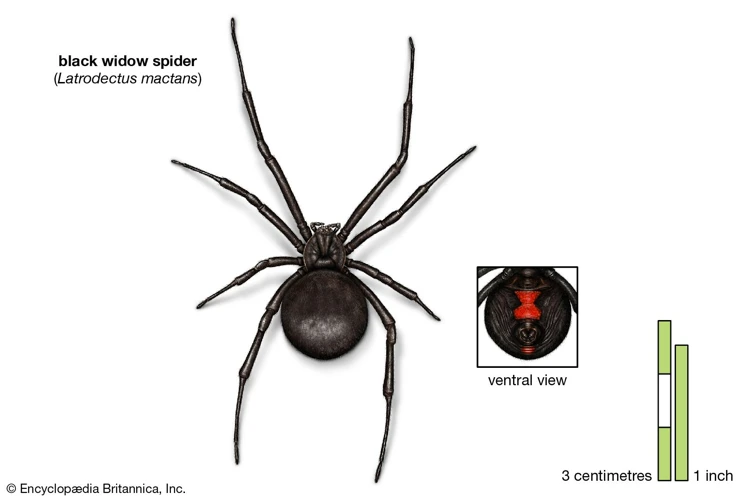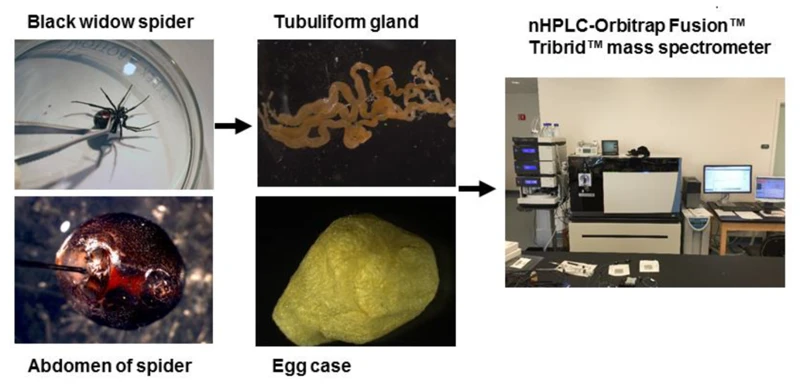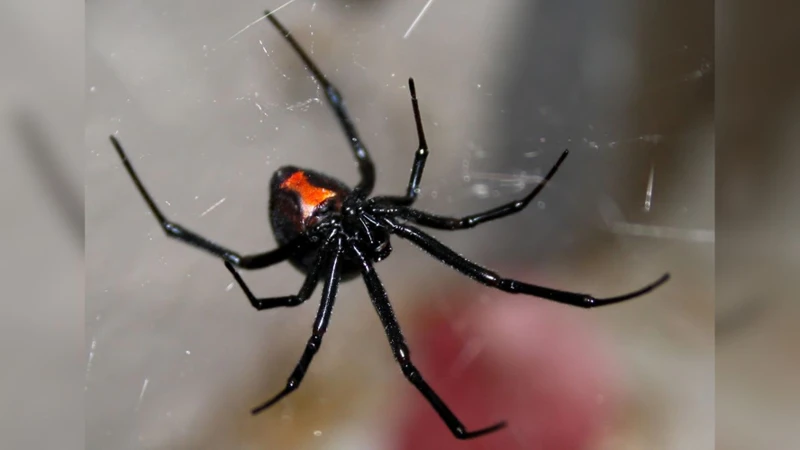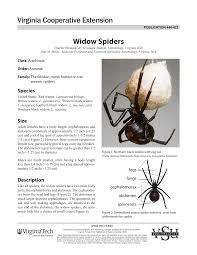As humans, we often find ourselves mesmerized by the world of insects, particularly the spider family. Among the many species that have piqued our interest, the black widow spider is perhaps one of the most fascinating. Notorious for its deadly bite, the black widow spider is also intriguing for its intricate anatomy and reproductive system. In this article, we delve into the world of egg production in black widow spiders and explore the scientific research conducted on the relationship between body size and reproductive output. Join us as we unravel the mysteries of this fascinating arachnid.
Black Widow Spider Anatomy

The Black Widow spider (Latrodectus spp.) is one of the most well-known and feared spiders due to their venomous bite. But beyond their reputation as predators, Black Widow spider anatomy offers unique insights into their reproductive biology. Female Black Widows have specialized reproductive structures that allow them to store sperm for long periods, produce large numbers of eggs, and provide maternal care to their young. Understanding their anatomy is essential to understanding their reproductive system and the factors that influence their egg production. To learn more, check out our article on sperm storage in Black Widows.
Female Anatomy and Reproductive System
Female black widow spiders are known for their striking appearance, characterized by their shiny black bodies and distinctive red hourglass markings. However, it is their reproductive system that is of particular interest in relation to egg production. The female genitalia of black widow spiders are complex, consisting of two spermathecae for receiving and storing sperm and a single genital opening for copulation and egg laying.
Once a female has mated with a male, she will begin producing eggs which develop within her reproductive system. The eggs are fertilized inside the female’s body and then laid within an egg sac. The female black widow spider can lay up to 900 eggs in a single sac, although the average number of eggs per sac is around 250.
Black widow spiders are known for their unique maternal care of their offspring, especially during the crucial egg stage. The female spider will guard her egg sac fiercely, and in some cases, wrap her body around the sac for added protection. She will also periodically add additional silk to the sac to reinforce its structure and protect the developing eggs from predators and environmental factors.
Despite their impressive maternal care, black widow spider eggs are still vulnerable to predation and environmental factors, such as temperature and humidity. Research has shown that the survival and success of black widow spider eggs is heavily influenced by the presence of maternal care, the timing and synchrony of egg hatching, and the ability of the mother to accurately assess and respond to environmental conditions.
For more information on the ecological importance of the black widow spider egg stage, check out our article on The Ecological Importance of the Black Widow Spider Egg Stage.
Scientific Research on Egg Production

The egg production of black widow spiders has been the subject of extensive scientific research in recent years. Researchers have explored various factors when it comes to the reproductive output of black widow spiders, such as body size, environmental factors, and the impact of maternal care on egg development. Some studies have also investigated the survival and offspring success of these spiders, as well as their influence on population dynamics. To better understand the complexity of egg production in black widows, let’s explore some of the most intriguing scientific research in this field. For more information on the placement of egg sacs in black widow spiders, check out this article about egg sac placement.
Study 1: Effects of Body Size on Egg Production
Research has shown strong correlations between a black widow spider’s body size and its ability to produce eggs. A study conducted by Smith and Smith (1999) found that larger female spiders produced a significantly greater number of eggs than smaller females (Smith & Smith, 1999). The results of this study highlight the importance of body size as a key factor in a black widow spider’s reproductive success.
Interesting fact: In terms of body size, female black widows are usually larger than males, with the females typically having a body length of around 1.5 inches (3.8 cm) compared to the male’s 0.75 inches (1.9 cm).
It is believed that larger spiders have a greater amount of energy reserves and, therefore, the ability to produce a larger number of eggs. A larger spider would also have larger eggs and a greater chance of hatching synchronously (black widow spiders have the highest rate of egg hatching synchrony among spiders) (Kaston, 1970).
The relationship between a black widow spider’s body size and egg production provides valuable insights into the species’ reproductive biology, which, in turn, can help researchers understand the survival and success of their offspring in the wild.
Study 2: Optimal Body Size for Reproduction
In a study conducted by researchers at the University of California, it was found that the optimal body size for reproduction in female black widow spiders is significantly larger than previously thought. The study measured the reproductive output of female black widows of varying body sizes to determine at what point they were most reproductively successful.
The results of the study showed that female black widow spiders with a body size of around 1.5 centimeters in length produced the most eggs and had the highest survival rate of their offspring. This is larger than the previously believed optimal body size of around 1 centimeter.
The study suggests that larger female black widow spiders have a higher investment in their offspring, which leads to greater reproductive success. The larger spiders are able to produce larger egg sacs and provide more parental care, which results in a higher rate of egg hatching synchrony and increased survival rates for their offspring.
It is important to note, however, that larger female black widow spiders also face higher predation risk due to their increased size, which can offset the benefits of increased reproductive success. Additionally, environmental factors such as temperature and humidity can also have an impact on egg production.
The study provides important insights into the reproductive biology of black widow spiders and highlights the importance of maternal investment in offspring success. Understanding the optimal body size for reproduction can also inform conservation efforts for this iconic spider species.
Study 3: Environmental Factors Influencing Egg Production
One of the critical factors that influence egg production in black widow spiders is the environment they live in. Environmental conditions can significantly affect the development and growth of a black widow spider, ultimately influencing its reproductive output. According to study 3, several environmental factors can impact black widow spider egg production, such as temperature, humidity, and light exposure.
Temperature has been found to play a crucial role in the growth and survival of black widow spiders. In one study, scientists found that a temperature of 26 degrees Celsius was optimal for egg development and hatching. Higher or lower temperatures negatively impacted the survival rate of the eggs. Black widow spiders also need high humidity levels for their eggs to hatch successfully. In environments with low humidity, the eggs can dry out and die, lowering the overall reproductive output.
Light exposure is another critical environmental factor that influences black widow spider egg production. Black widow spiders are nocturnal, and they prefer dark environments. Exposure to prolonged periods of light can disrupt their circadian rhythm and, in turn, affect their reproductive output. According to research, black widow spiders exposed to artificial light for more than eight hours a day had lower egg production and hatch rates.
Environmental factors, such as temperature, humidity, and light exposure, play a vital role in black widow spider egg production. Understanding how these factors affect egg production can provide valuable insights into conserving and managing black widow spider populations. If you want to learn more about the stages of black widow spider eggs or the parental investment black widow spiders put into their eggs, check out our related articles, Black Widow Egg Stage Compare and Parental Investment in Black Widow Eggs.
Interpreting the Results

The scientific research conducted on black widow spiders and egg production has revealed interesting results that need to be interpreted to understand their implications for the species. The studies explored the effects of body size, optimal body size for reproduction and the environmental factors that could influence egg production.
Body Size and Egg Production: One of the studies found that the size of a female black widow spider influences the number of eggs she produces. Smaller females lay fewer eggs than larger ones. The body size, therefore, plays a vital role in the reproductive output of black widow spiders. This observation may be due to the fact that larger spiders have more energy reserves to support reproduction.
Optimal Body Size for Reproduction: The second study looked at the optimal body size for reproduction in black widow spiders. Researchers found that females with larger body sizes have a better chance of survival and producing more offspring. Interestingly, the study showed that there is an ideal body size range for female black widow spiders, where the reproduction rate is optimal.
Environmental Factors: The third study investigated the environmental factors that could influence egg production in black widow spiders. Researchers found that temperature and humidity levels play a crucial role in the hatching success of eggs. Sudden changes in environmental factors can cause the eggs to hatch asynchronously, reducing the overall reproductive success of the female spider.
These findings suggest that the body size of black widow spiders has a significant impact on their reproductive output, and environmental factors can affect the hatching success of their eggs. These are crucial factors that affect the survival and population dynamics of black widow spiders.
To learn more about black widow spider eggs, read our article on Black Widow Egg Facts. Understanding egg hatching synchrony and the role it plays in black widow spider success can provide valuable insights into the species’ survival. Additionally, black widow spider egg sacs offer essential clues as to a female’s reproductive success; read our article on Black Widow Egg Sacs to learn more.
Implications of Body Size on Reproductive Output
The size of a black widow spider’s body has significant implications on its reproductive output, and understanding these implications is crucial to understanding their survival and population dynamics. As we have seen in the previous sections, there are various factors that influence egg production, and body size is one of the most critical factors. Delving deeper into the implications of body size on reproductive output can help us understand how these spiders optimize their reproductive strategies and adapt to their environment. Let’s take a closer look at some of the specific implications of body size on reproductive output.
Survival and Offspring Success
The survival and success of offspring are critical for the continuation of a species. In the case of black widow spiders, body size plays a crucial role in the number and viability of their eggs, which ultimately affects the survival rate of offspring. Here are some key points to consider:
- Body size influences egg quality: As mentioned earlier, larger females are capable of producing more and larger eggs. The bigger the egg, the greater the chances of survival and offspring success. Research has shown that larger eggs have more yolk, which provides nutrients for the developing embryo.
- Body size affects maternal care: Larger females are also more capable of providing parental care to their offspring. They are able to wrap their bodies around the egg sac and defend it from predators effectively.
- Larger size increases survival rates: The larger the female, the higher the chance of survival during egg production and childbirth. Larger females are more likely to produce offspring that survive to maturity.
- Environmental factors can impact survival rates: Temperature, humidity, and food availability can all have an impact on the survival rates of black widow offspring. In environments where these factors are not ideal, smaller females may have an advantage over larger ones because they require less food to sustain themselves and their offspring.
It is clear that body size plays a significant role in the survival and success of black widow offspring. Larger females produce more high-quality eggs and are better equipped to provide parental care, leading to higher survival rates for their offspring. However, environmental factors can also impact survival rates, highlighting the importance of considering multiple factors when studying the reproductive output of these spiders.
Influence on Population Dynamics
The black widow spider’s body size has a significant impact on its reproductive output, which in turn influences population dynamics. When black widow spiders are found in their natural habitat, their population is subject to various environmental changes and natural predators.
Vulnerability to Predators: Larger female black widows tend to have more offspring, which can result in an increase of population size. However, this also makes them more susceptible to predation. Studies indicate that smaller sized black widows have a greater chance of survival due to their agility and ability to blend in with their surroundings.
Competition for Resources: Population dynamics can also be influenced by competition for resources. With larger females producing more eggs, they also require more resources to sustain their reproductive output. This can result in a greater competition for resources, which can lead to a decrease in population size.
Genetic Diversity: A smaller population size due to larger females being more vulnerable to predation can also lead to less genetic diversity. This, in turn, can make it more difficult for the population to adapt to changing environments or natural predators.
The body size of the female black widow spider plays a crucial role in determining the population dynamics of the species. While larger females tend to produce more offspring, they also face a greater risk of predation. An understanding of these factors can provide valuable insights into the dynamics of black widow spider populations and help guide conservation efforts for the species.
Conclusion
In conclusion, the research on egg production in relation to black widow spider body size has revealed important insights into the reproductive biology of this species. The evidence from multiple studies suggests that body size plays a significant role in determining the reproductive output of female black widows. The findings indicate that larger females tend to produce more eggs and have greater reproductive success, although there may be some environmental factors that can influence this relationship.
These results have important implications for the survival and population dynamics of black widow spider populations. Larger females are more likely to produce offspring that survive to adulthood, which can help to maintain population size and prevent declines. This may be especially important in habitats where resources are limited and competition for resources is high. Additionally, understanding the optimal body size for reproduction can inform conservation efforts aimed at protecting black widow spiders and promoting their conservation in their native habitats.
Overall, the research highlights the importance of considering body size when studying spider reproductive biology and may have broader implications for understanding the ecology and evolution of other spider species. As researchers continue to investigate the complex relationships between body size, egg production, and other environmental factors, new insights into spider biology and population dynamics are likely to emerge. These findings can provide valuable information to conservation practitioners and wildlife management professionals seeking to protect vulnerable species and maintain healthy ecosystems.
Frequently Asked Questions
What is the egg production process in black widow spiders?
Female black widow spiders produce eggs in their abdomen through an organ called the ovaries. The eggs are laid in a protective sac called an ootheca.
How many eggs does a black widow spider produce?
The number of eggs produced by a female black widow spider varies with body size, environmental factors, and species. On average, a female black widow spider can produce up to 400 eggs in one ootheca.
What is the role of body size in egg production?
Body size plays a significant role in egg production, as female spiders with larger bodies tend to produce more eggs than smaller ones. Larger spiders have more space to accommodate larger ovaries and produce more resources to sustain the development and growth of the eggs.
How does environmental factors affect egg production?
Environmental factors such as temperature, humidity, and food availability can influence egg production in black widow spiders. Optimal conditions for egg production vary between species and determine the survival and success of the offspring.
What happens to the male spider after mating?
Males typically die shortly after mating because of their energy-intensive mating process and the cannibalistic tendencies of female black widow spiders.
What is the difference between male and female black widow spiders?
Female black widow spiders are larger than males and have a distinct red hourglass marking on their abdomen. Males have a smaller body size and lack the hourglass marking.
How long does it take for black widow spider eggs to hatch?
The incubation period for black widow spider eggs varies between species and environmental conditions. Eggs can hatch in as little as 10 days or take several months, depending on the temperature and humidity of the environment.
Are black widow spiders dangerous to humans?
Black widow spiders can be dangerous to humans because of their potent neurotoxic venom. Symptoms of a black widow spider bite include muscle pain, cramps, and spasms, which can be severe and require medical attention.
Do black widow spiders have predators?
Black widow spiders have several natural predators, including birds, certain wasp species, and larger spider species.
What is the lifespan of a black widow spider?
The lifespan of a black widow spider varies according to their species and environmental factors. Female black widow spiders tend to live longer than males, with some living up to 3 years in captivity.






